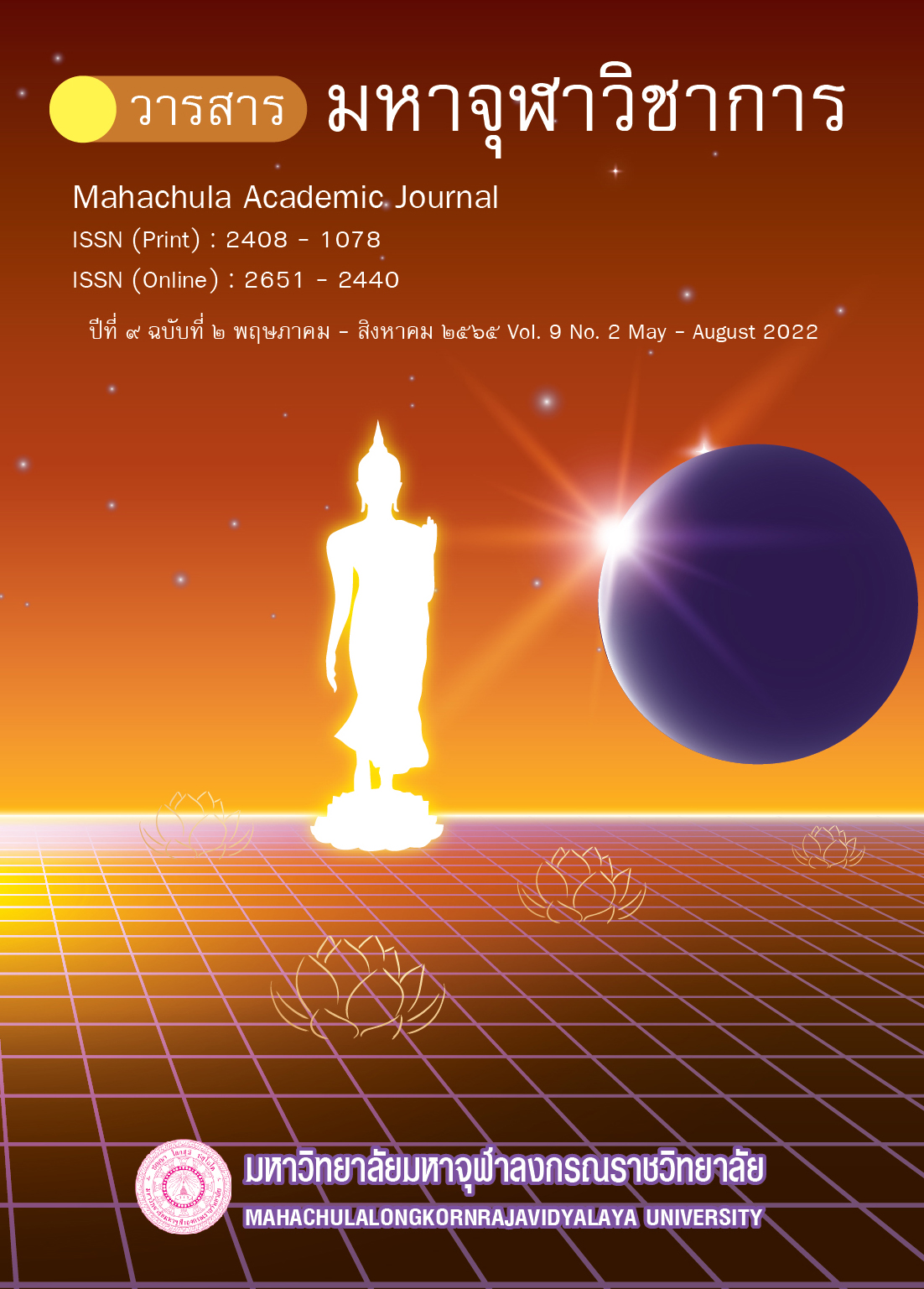The Guidelines of Enhancing the Social Responsibility Based on Puññakiriyā-vatthu (bases of meritorious action)
Main Article Content
Abstract
In this research entitled “The Guidelines of Enhancing the Social Responsibility Based on Puññakiriyā-vatthu” (bases of meritorious action), there are three objectives: (1) to study the problems of the responsibility for Thai society in the present, (2) to study the principles of “Puññakiriyā-vatthu” in Buddhist scriptures, and (3) to propose the ways to enhance the social responsibility based on the principles of “Puññakiriyā-vatthu”. This research is qualitative research with documentary information, and in-depth interviews of five Buddhist scholars as the key informants and sixteen people lived in Muang-Nonthaburi District.
The results of the research were found that there are 3 problems of the responsibility towards Thai society in the present such as: (1) Selfishness and lack of sympathy; (2) Lack of discipline and taking advantage of others; and (3) Lack of consciousness to control self-emotion. The Buddhist scholars and the interviewed people were of the opinion that. these problems were caused by the misuse of technology and social media. Presently people in Thai society do not mostly understand the word “Puññakiriyā-vatthu”, but know the words “giving alms”, “keeping precepts”, and “meditating”. The word “Puññakiriyā-vatthu”, that was appeared in the “Sangkhithi Sutra” and the “Puññakiriyā-vatthu Sutra” and was additionally explained by the exegetes, means such 3 types of making merits as “Dānamaya”, “Sīlamaya”, and “Bhāvanāmaya”. Which used as the guidelines for enhancing the social responsibility in 4 levels: (1) responsibility for citizenchip, (2) responsibility to the family, (3) responsibility to educational institutions, and (4) responsibility to friends.The guidelines of enhancing the social responsibility based on the principles of “Puññakiriyā-vatthu” can be done by “LOVE Model” which is giving correct knowledge of “Puññakiriyā-vatthu”. The examples of giving alms are setting of group activity to offer food to monks, donating the objects to the community, setting group activities for public benefits, and creating communication channels on social media among the temples and the community. The examples of keeping precepts are making the recording schedules of daily behavior, and publicizing the campaign of cooperating to follow the regulations. The examples of meditating are setting the activities of practicing mindfulness and insight meditation to be taught by insight meditation monks or experienced moderators. Other online-format activities can be set in the current situation such as the activities of chanting, listening to the dhamma, sitting and walking meditation with live broadcasts via Facebook, Zoom or other online applications in order to stimulate alertness and to more often approach new normal formats of meditation, including the activities with online applications in the form of practicing schedules “Mind Gym” which focusing on the completely practice of Puññakiriyā-vatthu each day, especially mindfulness to be aware of the current mood until able to control their own emotions lead to develop the mind to reach the level of wisdom.
Article Details

This work is licensed under a Creative Commons Attribution-NonCommercial-NoDerivatives 4.0 International License.
References
กิตติกร เกื้อกูล (ปากกาสีเงิน). เบิกบาน พุทธวิถีเพื่อความงดงามของชีวิต. กรุงเทพมหานคร: บริษัท รุ่งแสงการพิมพ์ จำกัด, ๒๕๕๖.
กันตภณ หนูทองแก้ว. “การนำหลักบุญกิริยาวัตถุมาใช้ในวิถีชีวิตของประชาชน อำเภอเมือง จังหวัดนครศรีธรรมราช พ.ศ. ๒๕๕๖”. สารอาศรมวัฒนธรรมวลัยลักษณ์. ปีที่ ๑๕ ฉบับที่ ๑ (ตุลาคม ๒๕๕๗ – มีนาคม ๒๕๕๘) : ๑๖๕.
พระภัทรนันต์ ฐิตเสฏฺโฐ และคณะ. “ศึกษาวิเคราะห์บุญกิริยาวัตถุ ๓ ที่ปรากฏในคัมภีร์อรรถกถาธรรมบท”. วารสารปัญญาปณิธาน. ปีที่ ๑ ฉบับที่ ๑ (มกราคม-มิถุนายน ๒๕๕๙): ๒๖.
ภูริตา บุญล้อม. “รู้จักโรคทนรอไม่ได้ (Hurry Sickness) พร้อมกับ ๖ สัญญาณช่วยเช็คว่าคุณกำลังเป็นโรคนี้อยู่หรือเปล่า”. [ออนไลน์]. แหล่งที่มา: https://thestandard.co/hurry-sickness/ [๑ กันยายน ๒๕๖๔].
มหาจุฬาลงกรณราชวิทยาลัย. พระไตรปิฎกภาษาไทย ฉบับมหาจุฬาลงกรณราชวิทยาลัย. กรุงเทพมหานคร: โรงพิมพ์มหาจุฬาลงกรณราชวิทยาลัย, ๒๕๓๙.
สำนักเลขาธิการสภาการศึกษา กระทรวงศึกษาธิการ. รายงานการศึกษาไทย พ.ศ. ๒๕๖๑ (Education in Thailand 2018). พิมพ์ครั้งที่ ๑. กรุงเทพมหานคร: บริษัท พริกหวานกราฟฟิค จำกัด, ๒๕๖๑.
สถานทูตสหรัฐและสถานกงสุลในประเทศไทย. รายงานว่าด้วยเสรีภาพทางศาสนานานาชาติในประเทศไทย พ.ศ. ๒๕๖๓. [ออนไลน์]. แหล่งที่มา: https://th.usembassy.gov/th/our-relationship-th/official-reports-th/2020-international-religious-freedom-report-thailand-th/ [๑๖ สิงหาคม ๒๕๖๔].
สำนักงานคณะกรรมการพัฒนาเศรษฐกิจและสังคมแห่งชาติ สำนักนายกรัฐมนตรี.“แผนพัฒนาเศรษฐกิจและสังคมแห่งชาติ ฉบับที่ ๑๒ (พ.ศ. ๒๕๖๐ - ๒๕๖๔)”. ๔๓. [ออนไลน์]. แหล่งที่มา: http://plan.bru.ac.thแผนพัฒนาเศรษฐกิจและสังคมแห่งชาติ-ฉบับที่-12/ [๒๐ สิงหาคม ๒๕๖๔].
Pawinee. “ภัยใกล้ตัว! โรคทนรอไม่ได้ (ไอเอ็นเอ็น)”. [ออนไลน์]. แหล่งที่มา: https://www.hsri.or.th/people/media/care/detail/5779 [๑ กันยายน ๒๕๖๔].


